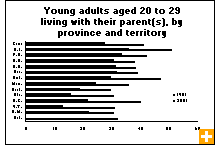Common menu bar links
Young adults waiting to start families
Archived Content
Information identified as archived is provided for reference, research or recordkeeping purposes. It is not subject to the Government of Canada Web Standards and has not been altered or updated since it was archived. Please contact us to request a format other than those available.
They have been called the boomerang kids and the generation on hold. Nowadays, there are more and more young adults who are slow to leave the family home or are actually returning to it.
In 2001, 41% of the 3.8 million young Canadian adults aged 20 to 29 lived with their parents, compared with 28% in 1981. This trend was particularly strong among young men, 47% of whom lived with their parents, compared with 35% of young women. Pursuing an education, chasing elusive jobs, falling marriage rates, choosing common-law arrangements and postponing their first marriage are all factors in this trend.
With more and more young people having second thoughts about leaving the nest, the number of conjugal relationships keeps decreasing among young adults. In 2001, 35% of young people aged 20 to 29 were married or in a common-law relationship, compared with 52% in 1981. Most of these young people chose to try living common law as a first conjugal experience, and then ended up getting married.
 The first experience with conjugal relationships among young men and women is more likely to end in separation or divorce than among older people. More break-ups lead to more second conjugal relationships and more blended families. It also leads to an increase in the number of people living alone and to more single-parent families.
The first experience with conjugal relationships among young men and women is more likely to end in separation or divorce than among older people. More break-ups lead to more second conjugal relationships and more blended families. It also leads to an increase in the number of people living alone and to more single-parent families.
In 2001, married couples and those in common-law relationships with children aged 24 or under living at home represented only 44% of all families, compared with 55% in 1981. The proportion of couples without children living at home was 41%, up from 34% in 1981.


